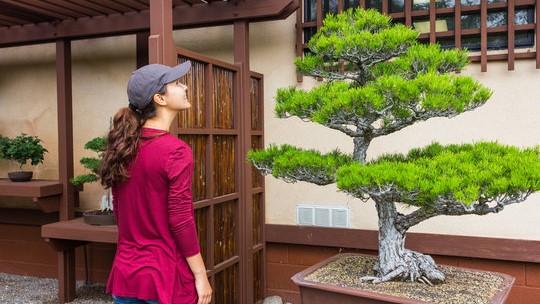With its spiral trunk and unpredictable branching, the Moyogi Style, also known as the ‘informal upright’ style, is a captivating facet of Bonsai cultivation that encompasses a profound wealth of history and artistry. Deriving from ancient traditions, this elusive form allows both nature and the artist to harmonize in creating a miniature tree that’s a vivid embodiment of life’s resilience and continual evolution.
Venturing beyond its exquisite aesthetics, it’s essential to delve deeper to truly appreciate the intricate layers that contribute to this craft. This exploration unpacks the foundational aspects of the Moyogi style, the tree species best suited for it, the specific techniques applied in its cultivation, and the ongoing care required to keep these living artworks flourishing.
Understanding the Basics
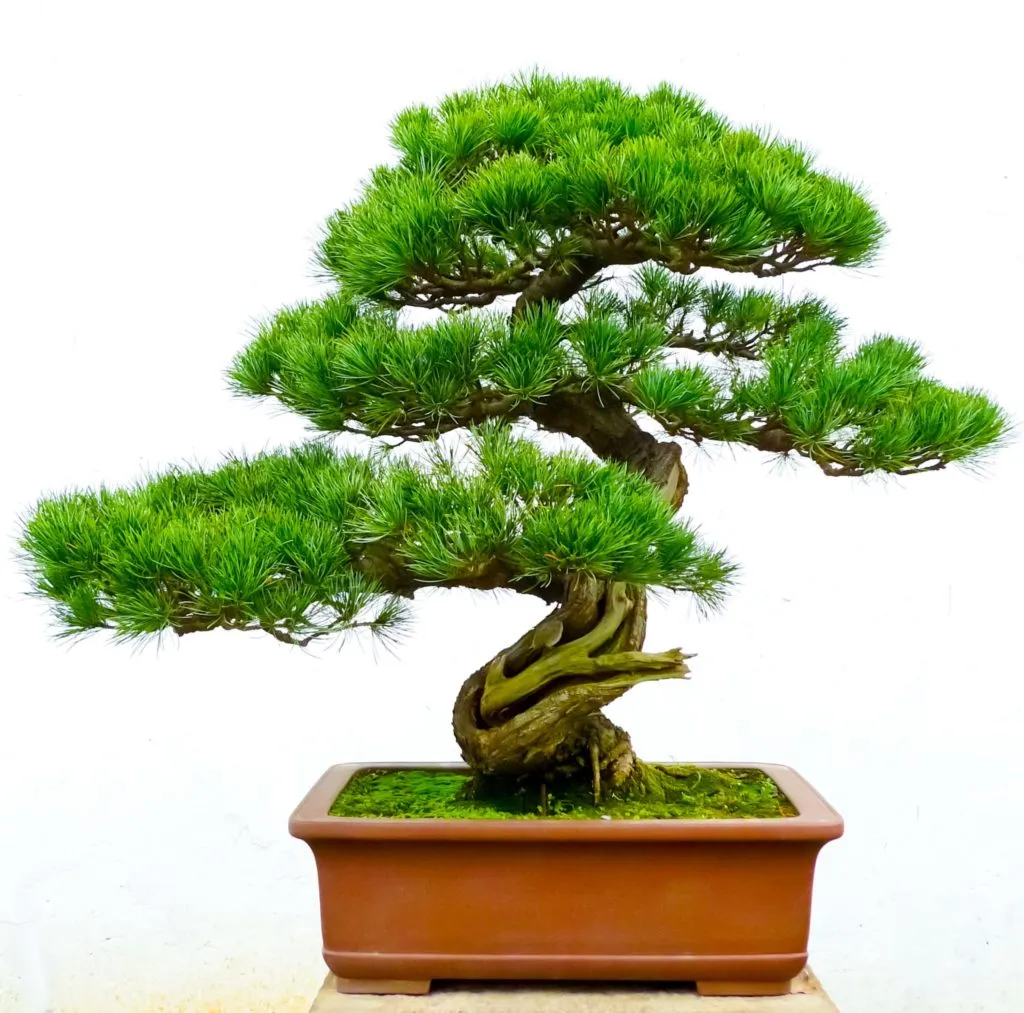
Understanding Moyogi Style: Historical context and Cultural Significance
Moyogi, also widely known as the informal upright style, is one of the most popular styles in Bonsai artistry and has made its mark on both Japanese and International Bonsai history. The inception of this style stems from the tradition of depicting nature in its most organic and realistic form. The natural, upright, contoured structure of the Moyogi style makes it a reflection of trees in their native environments, particularly those located in mountainous areas or regions exposed to strong winds.
Despite being a Japanese art, the influences of the Moyogi style can be traced back to the ancient Chinese practice of “penjing”. The art form was then adapted and refined by the Japanese, creating a unique blend of artistic expression and horticultural expertise that is reflective of natural landscapes. The cultural significance of the Moyogi style is vast, serving as a symbol of harmony between man, soul, and nature – fostering peace, strength, and resilience.
Aesthetic Attributes and Key Unique Characteristics of Moyogi Style
The Moyogi Bonsai stands out for its informal yet graceful upright form. Each Bonsai crafted in this style is intended to evoke a sense of individual character, strength, and elegance. Unlike the formal upright style (“Chokkan”), the Moyogi style displays a more curvilinear form with gentle, irregular twists and turns that mimic the random growth patterns of trees found in nature.
One of the primary aesthetic attributes of the Moyogi style is the curve of the trunk. It begins to curve at the soil surface and continues to do so, yet still maintains its general upward movement. The goal is to simulate the tree’s struggle against natural elements like wind and gravity.
Another unique characteristic of the Moyogi style is the branching pattern. The branches are arranged in an alternating pattern, creating a balancing act between the direction of the trunk’s movement and the spread of the branches. The lowest branch often droops slightly downward, displaying the tree’s maturity and age, while the higher branches exhibit more vigor.
Mastery of the Moyogi Bonsai: Unveiling Nature’s Artistry
The path to creating a captivating Moyogi Bonsai is a journey of patience and precision, beginning with the choice of the perfect tree specimen. The chosen tree should ideally demonstrate the potential to resemble a mature tree growing naturally, encapsulating attributes such as bark texture, leaf style, and a harmonious balance between its trunk and branches.
Wire-training is a key technique deployed in the creation of the distinctive Moyogi shape. This tool aids in directing the tree’s growth while preserving its natural charm. It is essential to exercise patience during this phase to prevent the wire from cutting into the bark and causing harm to the tree.
Consistent trimming and pruning play a pivotal role in retaining the shape and form of a Moyogi Bonsai. It should encapsulate the essence of a tree that has experienced the push and pull of nature over time. With regular care, attention, and a profound understanding of its deeper aesthetic values, a well-crafted Moyogi Bonsai stands as a living symbol of nature’s resilience and elegance.

Choosing the Right Material
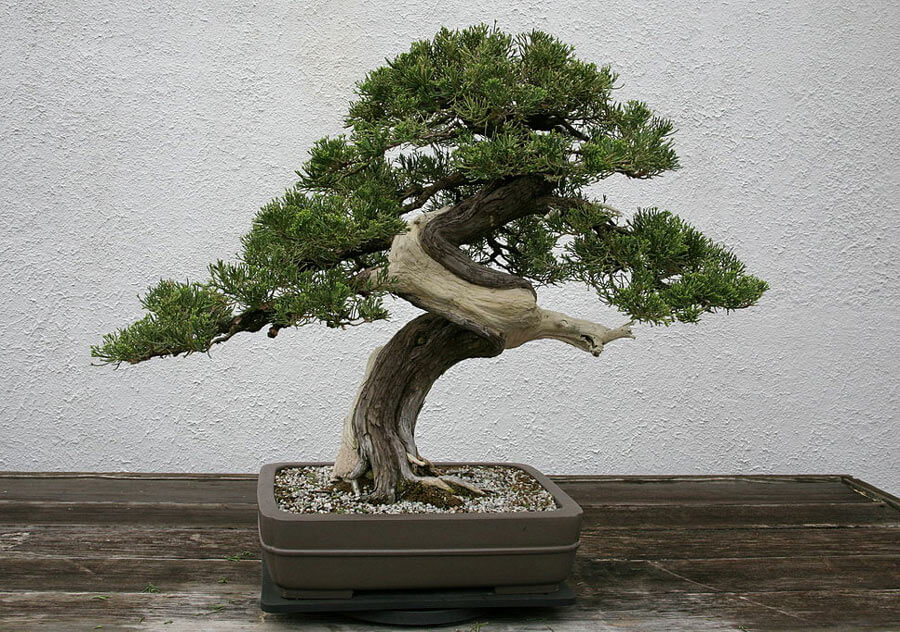
Selecting the Ideal Specimen for a Moyogi Bonsai
The journey towards crafting a Moyogi bonsai begins with a crucial decision – choosing the right tree species. Each tree has distinct features and growth patterns; therefore, some species might be better suited for this style than others. Although any species can be used, the unique challenges posed by each can influence the final shape and overall aesthetics of the bonsai.
The tree’s adaptability to training should be one of your top considerations. Certain trees are more tolerant to manipulation while others can be quite delicate and prone to damage. The Japanese Maple (Acer palmatum), Chinese Elm (Ulmus parvifolia), and Zelkova (Zelkova serrata) are popular choices for their adaptability and responsiveness to the training techniques used in shaping the branches and trunk.
The natural form of the tree also carries significant weight; a tree possessing a naturally curved or twisted trunk is easier to mold into the informal upright form of the Moyogi style in comparison to one with a straight and rigid trunk. However, remember that even the toughest of trees can be conditioned into the desired form with time, patience, and careful training.
Different tree species grow at varying rates, which can significantly influence the appearance of your bonsai; a species with a slower, more compact growth rate may facilitate in achieving and maintaining the gentle twists and turns of the Moyogi style, as compared to a rapidly and vigorously growing species.
Finally, consider the tree’s post-transplant recovery capabilities, as the transformation process can be stressful for the tree, involving root pruning, continuous trimming, and wiring. Some species recover faster and are more resilient, capable of surviving and thriving despite the stress of shaping.
In conclusion, the Moyogi style allows for some flexibility in the choice of tree species, but understanding certain variables such as the tree’s adaptability to training, natural shape, growth pattern, and recovery capabilities can simplify the process and enhance the success of your Moyogi bonsai creation.
Crafting Techniques and Tools
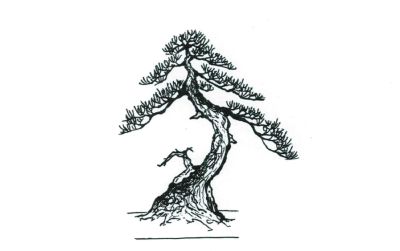
Mastering Techniques for Crafting a Moyogi Bonsai
The process of crafting a Moyogi or Informal Upright Bonsai harnesses several techniques, primarily encapsulating wiring, pruning, and repotting. Each technique leaves a distinct mark on the bonsai’s final form and overall well-being, necessitating caution and precision in their execution. Recognizing and applying these nuances correctly is key to crafting a healthy and visually pleasing Moyogi bonsai, reflecting the true essence of balance and aesthetic appeal.
Wiring Techniques
Central to Bonsai cultivation, wiring is the greatest tool a Bonsai artist has to control the direction growth of a tree. Carefully wrapping wire around the branches and trunk of a bonsai enables the artist to bend and reposition these components to achieve the desired shape.
In the Moyogi style, informal upright, one wire is wrapped around the trunk, which helps to give it a gentle curve. Smaller branches are also wired and bent downward so they take on the appearance of an old tree.
Specialized bonsai wires made from copper or aluminum should be used in this process. The wire size varies from 1mm to 4mm, depending on the thickness and strength of the branch or trunk.
The wire must be wound around the trunk at an angle of 45 degrees to get the most efficient shaping results. While wrapping the wire, ensure that it is not too tight to avert damaging the soft cambium layer underneath the bark.
Pruning Techniques
Pruning, a fundamental technique in bonsai cultivation, harnesses control over the tree’s shape and height while promoting its overall health.
In the Moyogi style, pruning must preserve the tree’s informal, yet balanced character. Begin by removing dead, broken, or crossing branches. Next, consider both the visual balance and the fundamental health of the tree while pruning upper and lower branches.
Sharp pruning shears are the basic tool used for this task. When pruning thicker branches, using a branch cutter or a saw would be more suitable. The wounds from pruning should be treated with a healing paste to prevent infection and promote quicker healing.
Repotting Techniques
Repotting is a crucial technique in bonsai cultivation, ensuring the tree’s health by refreshing the soil and root system.
A typical bonsai in the Moyogi style may need repotting every two to five years. This gives you an opportunity to prune the roots, which is important for maintaining the tree’s small size and health.
A root rake or hook is the ideal tool for combing and untangling roots without causing damage during the repotting process. Root pruning shears and root cutters are also useful in trimming thicker roots.
During repotting, one must be careful to maintain the aesthetic balance in the Moyogi style. This involves making sure the tree continues to slant to the right or the left while the apex leans back to the center.
Using Bonsai Tools Properly
Proper manipulation and maintenance of bonsai tools are crucial to execute these techniques effectively. Different types of shears, cutters, and wires, all have distinct purposes and should be used appropriately. It’s recommended to clean tools after each use to prevent the spread of diseases. Consider investing in a toolkit specific to bonsai cultivation to ensure high quality and durability.
Harnessing the power of bonsai crafting techniques and understanding their complexities allows the creation of a successful Moyogi Style or informal upright bonsai. This living work of art represents nature’s strength and equilibrium in a reduced form.
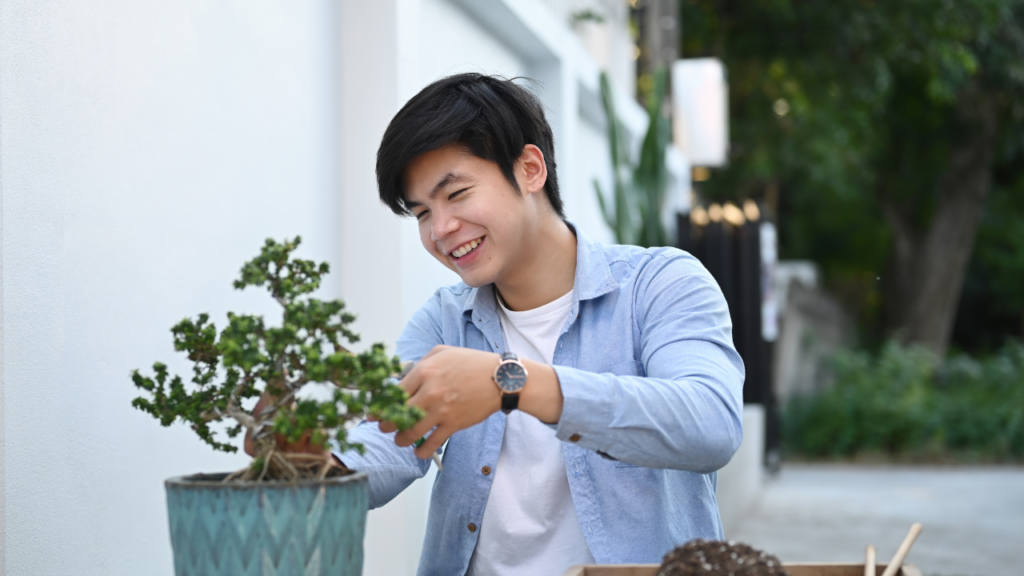
Care and Maintenance
Meticulous Care and Upkeep of Moyogi Bonsai: A Testament of Endurance and Devotion
What’s required in the care for a Moyogi Bonsai, like all other bonsais, is a significant amount of patience, commitment and sustained effort. The task doesn’t end with just modeling a small replica of a tree; it involves the continual care and attention needed to preserve the beauty of this living art piece over the span of many years, possibly decades.
Watering Needs for Moyogi Bonsai
Whether you are a bonsai enthusiast or a beginner, you should know that watering a bonsai is one of the most crucial responsibilities. For the Moyogi Bonsai, the watering routine is dependent on various factors such as the size of the tree, the size of the pot, the type of soil, the climate, and the time of year. As a thumb rule, don’t let your bonsai dry out completely. Always water thoroughly until you see water coming out of the drainage holes of the pot. Also, it’s better to water in the early morning or evening when the weather is cooler to reduce evaporation.
Fertilizing Your Moyogi Bonsai
Fertilizing is another critical aspect of maintaining a Moyogi Bonsai. Although the trees are usually grown in nutrient-rich soil, regular feeding is necessary to replenish the nutrients that the plant consumes. In general, bonsai need a balanced fertilizer that contains equal parts of Nitrogen (N), Phosphorus (P), and Potassium (K). The fertilizer requirements can vary based on the age of the tree, stage of growth, and portion of the year. Usually, the fertilizer is applied during the entire growing season, which is from spring through early autumn.
Winter Protection of the Moyogi Bonsai
Unlike the tall, wild trees, bonsai are not capable of enduring extreme weather conditions unaided. They need adequate protection during winter. The roots of a bonsai are vulnerable to freezing because they are confined to a small pot. Therefore, you need to take steps to ensure the safety of your Moyogi Bonsai during cold spells. These measures may include placing the bonsai in a protected cold frame or greenhouse, in a window well of your house, or even burying it (pot and all) in a protected part of your garden.
Pest Control for a Healthy Moyogi Bonsai
A Moyogi Bonsai tree is as susceptible to pests and diseases as any other plant. It’s essential to continuously inspect your tree for any signs of pests or disease. Common pests include aphids, red spider mites, and scale insects. Using organic pesticides can help control these pests without damaging the bonsai. Also, remember that prevention is the best cure. Maintaining a healthy tree is the best way to avoid most pest problems. Regular watering, feeding, and appropriate sunlight conditions contribute majorly towards a healthy tree.
To sum up, the Moyogi Style signifies a gracefully curved trunk of the tree that can shape both deliberately and naturally under specific conditions. It is one of the most popular styles in bonsai art because it portrays the real struggle of a tree becoming bigger and holding its own in hard conditions. And with the right care and maintenance, it’s possible to maintain and enhance the beauty of a Moyogi Bonsai.
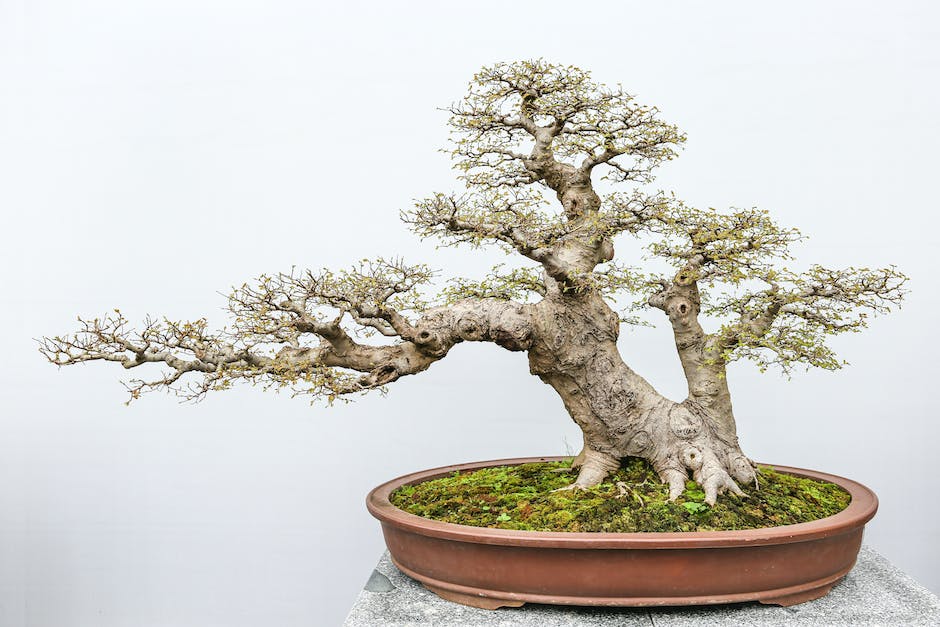
Patience, persistence, and passion are the unspoken credentials needed to venture into the Moyogi style bonsai cultivation. The journey involves witnessing the tree’s slow transformation, from being an ordinary plant to becoming a profound embodiment of resilience and beauty. The practice engulfs one in a life-long dedication, where constant care, monitoring, and adjustment shape the bonsai, the practice reflecting myriad life philosophy. The journey transcends mere horticultural practice, spilling into the realm of art and mindfulness. Embarking on this voyage of creating a Moyogi Bonsai, each enthusiast becomes an artist, intertwining their creative influence with the unscripted course of nature, resulting in an ever-evolving piece of living art.
